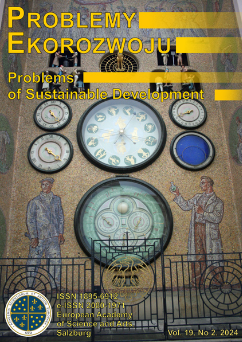Promoting Sustainability Through Green Chemistry, Part 1
Tadeusz Paryjczak
Instytut Chemii Ogólnej i Ekologicznej Politechniki Łódzkiej, 90-924 Łódź, ul. Żeromskiego 116, Poland (Poland)
Abstract
Green Chemistry is an important tool in achieving sustainability. The implementation of green chemistry, the design of chemical products and processes that reduce or eliminate the use and generation of hazardous substances, is essential if the expanding global populations to enjoy an increased standard of living without having a negative impact on the health of the planet. One of the major goods of sustainability is to maintain an optimal balance between increases in manufacturing output, and a clean and safe environment. Cleaner technologies will allow the chemical enterprise to provide society with the good and services on which it depends in an environmentally responsible manner. Green chemistry provides solutions to such global challenges as climate change, sustainable agriculture, energy, toxics in the environment and the depletion of natural resources. A collaborative effort by industry, academic and government is need to promote the adoption of the green chemistry technologies necessary to active a sustainable society.
Keywords:
green chemistry, sustainability, green technologies, principles of green chemistry, pollution preventionReferences
ANASTAS P.T., Green Chemistry, Theory and Practice, Oxford University Pess, 1998.
Google Scholar
ANASTAS P.T, BARTLETT L.B, KIRCHHOFF M.M, Williamson T.C.,2000, The role of catalysis in the design, development and implementation of green chemistry, w: Catalysis Today, vol. 55, s. 11-22.
Google Scholar
ANGELA M, MEIRELES A., 2003, Supercritical extraction from solid; Process design data (2001-2003), w: Current Opinion in Solid State and Materials Science, Vol. 7, s.321- 330.
Google Scholar
BURCZYK B., Zielona Chemia, zarys, Oficyna Wydawnicza Politechniki Wrocławskiej, Wrocław 2006.
Google Scholar
CATO M.P, Origenes – De Agricultura.
Google Scholar
CLARK J., MACQUARRIE D.J., Handbook of Green Chemistry and Technology, Blackwell, 44 Tadeusz Paryjczak/Problemy Ekorozwoju nr 3 (2008) , 39-44 2002.
Google Scholar
McDONOUGH W., BRAUNGART M, ANASTAS P.T, ZIMMERMAN J.B., 2003, Applying the Principles Engineering, w: Environ. Science and Technology, December 1, s. 435-441.
Google Scholar
GIRAY E.S., SONMEZ O.,2004, Supercritical extraction of scrap tire with different solvents and the effect of tire oil on the supercritical extraction of coal, w: Fuel Processing Technology, Vol. 85, s. 251-265.
Google Scholar
MATLACK A.S., Introduction to Green Chemistry, Mareel Dekker Inc., New York 2001.
Google Scholar
PARYJCZAK T., LEWICKI A., ZABORSKI M., Zielona Chemia, PAN, Oddział w Łodzi, Komisja Ochrony Środowiska, Łódź 2005.
Google Scholar
PARYJCZAK T., LEWICKI A., 2006, Kataliza w zielonej chemii, w: Przemysł Chemiczny, Vol. 2, s. 85-95.
Google Scholar
PARYJCZAK T., LEWICKI A., ZABORSKI M., Zielona chemia – przyszłość ochrony środowiska, w: red. Marciniec B., Misja chemii Wydawnictwo Poznańskie, Poznań 2004, s. 2990327.
Google Scholar
PAWŁOWSKI A., 2006, Wielowymiarowość rozwoju zrównoważonego, w: Problemy Ekorozwoju, Vol. 1, No 1, s. 23-32.
Google Scholar
PAWŁOWSKI A., 2007, Bariery we wdrażaniu rozwoju zrównoważonego – spojrzenie ekofilozofa, w: Problemy Ekorozwoju, Vol. 2, No 1, s. 59-65.
Google Scholar
PERNAK J., 2003, Ciecze jonowe. Związki na miarę XXI wieku, w: Przem. Chem., Vol. 8, s. 521.
Google Scholar
SHELDON R. A., 2000, Atom efficiency and catalysis in organic synthesis, w: Pure Appl. Chem., Vol. 72, No 7, s. 1233-1246.
Google Scholar
TROST M.B., 1991, Science No 254, s. 1471.
Google Scholar
WINTERTON N., 2001, Green Chem., No 3, s.73.
Google Scholar
YEO S.D., KIRAU E., 2005, Formation of polymer particles with supercritical fluids, w: A. Review supercritical Fluids, No 34, s. 287-308.
Google Scholar
AFONSO C.A.M., GRESPO J.G., (red.), Green Separation Processes Fundamentals and Application, Wiley-VCH Verlag, 2004.
Google Scholar
Authors
Tadeusz ParyjczakInstytut Chemii Ogólnej i Ekologicznej Politechniki Łódzkiej, 90-924 Łódź, ul. Żeromskiego 116, Poland Poland
Statistics
Abstract views: 11PDF downloads: 5
License

This work is licensed under a Creative Commons Attribution-ShareAlike 4.0 International License.




